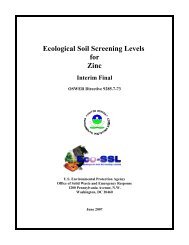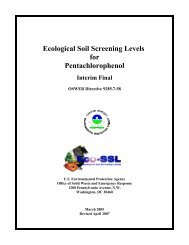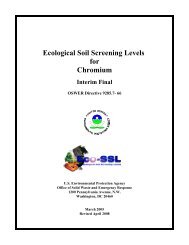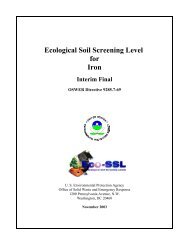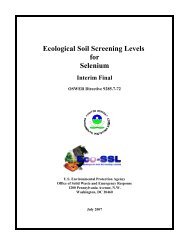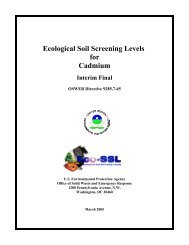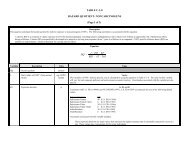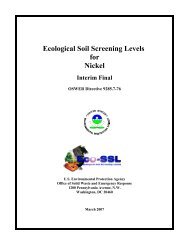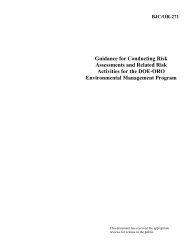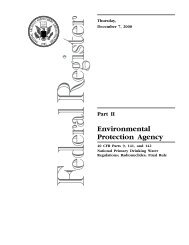Understanding Variation in Partition Coefficient, Kd, Values Volume II
Understanding Variation in Partition Coefficient, Kd, Values Volume II
Understanding Variation in Partition Coefficient, Kd, Values Volume II
You also want an ePaper? Increase the reach of your titles
YUMPU automatically turns print PDFs into web optimized ePapers that Google loves.
3.0 Methods, Issues, and Criteria for Measur<strong>in</strong>g <strong>Kd</strong> <strong>Values</strong><br />
There are 5 general methods used to measure K d values: the batch laboratory method, laboratory<br />
flow-through (or column) method, field-batch method, field model<strong>in</strong>g method, and K oc method. These<br />
methods and the associated technical issues are described <strong>in</strong> detail <strong>in</strong> Chapter 3 of <strong>Volume</strong> I. Each<br />
method has advantages and disadvantages, and perhaps more importantly, each method has its own set<br />
of assumptions for calculat<strong>in</strong>g K d values from experimental data. Consequently, it is not only common,<br />
but expected that K d values measured by different methods will produce different values.<br />
3.1 Laboratory Batch Method<br />
Batch tests are commonly used to measure K d values. The test is conducted by spik<strong>in</strong>g a solution with<br />
the element of <strong>in</strong>terest, mix<strong>in</strong>g the spiked solution with a solid for a specified period of time, separat<strong>in</strong>g<br />
the solution from the solid, and measur<strong>in</strong>g the concentration of the spiked element rema<strong>in</strong><strong>in</strong>g <strong>in</strong> solution.<br />
The concentration of contam<strong>in</strong>ant associated with the solid is determ<strong>in</strong>ed by the difference between<br />
<strong>in</strong>itial and f<strong>in</strong>al contam<strong>in</strong>ant concentration. The primary advantage of the method is that such experiments<br />
can be completed quickly for a wide variety of elements and chemical environments. The<br />
primary disadvantage of the batch technique for measur<strong>in</strong>g K d is that it does not necessarily reproduce<br />
the chemical reaction conditions that take place <strong>in</strong> the real environment. For <strong>in</strong>stance, <strong>in</strong> a soil column,<br />
water passes through at a f<strong>in</strong>ite rate and both reaction time and degree of mix<strong>in</strong>g between water and<br />
soil can be much less than those occurr<strong>in</strong>g <strong>in</strong> a laboratory batch test. Consequently, K d values from<br />
batch experiments can be high relative to the extent of sorption occurr<strong>in</strong>g <strong>in</strong> a real system, and thus<br />
result <strong>in</strong> an estimate of contam<strong>in</strong>ant retardation that is too large. Another disadvantage of batch experiments<br />
is that they do not accurately simulate desorption of the radionuclides or contam<strong>in</strong>ants from a<br />
contam<strong>in</strong>ated soil or solid waste source. The K d values are frequently used with the assumption that<br />
adsorption and desorption reactions are reversible. This assumption is contrary to most experimental<br />
observations that show that the desorption process is appreciably slower than the adsorption process, a<br />
phenomenon referred to as hysteresis. The rate of desorption may even go to zero, yet a significant<br />
mass of the contam<strong>in</strong>ant rema<strong>in</strong>s sorbed on the soil. Thus, use of K d values determ<strong>in</strong>ed from batch<br />
adsorption tests <strong>in</strong> contam<strong>in</strong>ant transport models is generally considered to provide estimates of<br />
contam<strong>in</strong>ant remobilization (release) from soil that are too large (i.e., estimates of contam<strong>in</strong>ant retention<br />
that are too low).<br />
3.2 Laboratory Flow-Through Method<br />
Flow-through column experiments are <strong>in</strong>tended to provide a more realistic simulation of dynamic field<br />
conditions and to quantify the movement of contam<strong>in</strong>ants relative to groundwater flow. It is the second<br />
most common method of determ<strong>in</strong><strong>in</strong>g K d values. The basic experiment is completed by pass<strong>in</strong>g a liquid<br />
spiked with the contam<strong>in</strong>ant of <strong>in</strong>terest through a soil column. The column experiment comb<strong>in</strong>es the<br />
chemical effects of sorption and the hydrologic effects of groundwater flow through a porous medium to<br />
provide an estimate of retarded movement of the contam<strong>in</strong>ant of <strong>in</strong>terest. The retardation factor (a ratio<br />
3.1



